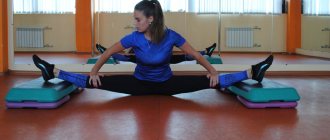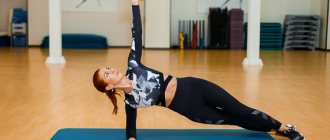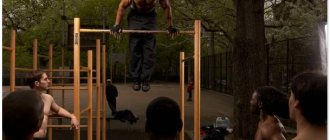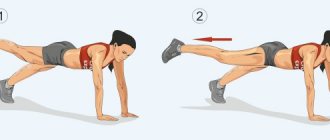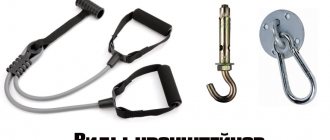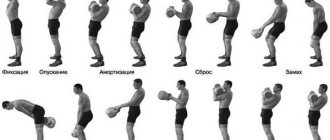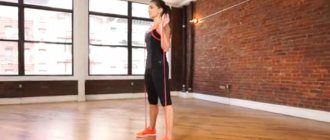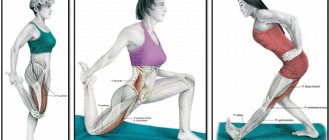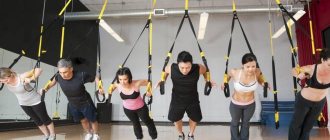Currently, the fitness industry is developing very intensively. More and more people are trying to get their bodies in good shape. But at the same time they forget about health. “How? After all, physical exercise improves well-being and has a beneficial effect on the body!” – you say. Without a doubt! However, in every activity there are two sides to the coin. And the field of sports or fitness is no exception.
A person who has never been involved in professional sports or, at least, has not led an active lifestyle during the past years, when he comes to the gym, begins to “pull” iron and master more and more new exercise machines. What does this lead to? When your musculoskeletal system is not ready to work even with the weight of your own body, you begin to “hang” another couple of tens of kilograms on it.
Without knowledge of proper exercise technique, you diligently break weight lifting records in the race for the ideal figure. If this is the case, then expect to get injured soon.
How then to train without harm to your health? The best replacement for exercise equipment is rubber loops. These are the ones that will be discussed in this guide.
What are rubber loops?
Rubber loops (rubber bands) are a universal, multifunctional piece of equipment that can become for you not only the best replacement for exercise equipment, but will also perfectly complement them. This is a great helper for those who want to increase strength, pump up muscles, lose weight, create a beautiful body or learn how to perform complex gymnastic elements.
If you find yourself on this list, then it’s time to think about purchasing rubber loops. However, besides them, there are other types of projectiles of this type.
Overview: Elastic Bands, Rubber Bandages, Bandages and Loops
The advantages and disadvantages of each are discussed below.
Elastic tape
Pros:
Minuses:
|
Martens rubber bandage
pros
Minuses:
|
Rubber band
Pros:
Minuses:
|
Rubber loops
Pros:
Minuses:
|
Why are red loops needed?
This type of rubber bands fully corresponds to their original purpose. Thanks to the orange models, you can complicate strength exercises by adding a static-dynamic nature of the load to their biomechanics. A little resistance allows for gradual progress. A muscle stereotype is established that does not disrupt the general innervation of the muscles. Quite often, athletes completely replace barbells and dumbbells with various bands. Of course, there are many advantages of such training, but many forget the fact that you cannot immediately abandon standard weights and replace them with a huge static-dynamic load.
The body cannot retrain muscle cells and the central nervous system with motor neurons at such a speed. This requires a smooth and gradual introduction to training. This can only be done using tapes with weak resistance. Each workout, the athlete reduces the number of weights on the barbell and adds an equal number of orange loops. Thus, the overall load factor remains the same, but the type of muscle contractions gradually changes. The smooth transition of this format allows you to get the greatest benefit from using rubber bands.
In general, we can say with confidence that the main way to use orange loops is to supplement strength exercises with static-dynamic load, and we are talking about both free weights and all kinds of exercise machines.
Exercises with rubber loops at home and in the gym
Training with rubber loops can not only fully replace trips to the gym, but also significantly complement the use of exercise equipment. Now we will look at the most common exercises with loops for various parts of the body.
Arm muscles
Shoulder external rotation using a sling
Pass one end of the rubber loop through the other, placing it around your waist. Grasp the edges of the loop. With one hand, pull the loop to the side.
Press the elbow of your other hand to the crest of the pelvic bone and tense your hand. Rotate your shoulder in the opposite direction from your body (outward) and return it back.
The rubber loop must be in a constant state of tension. Don't let your wrist fall, it should be in one line with your forearm.
External rotation of the shoulder using an expander
One arm abduction using a rubber band
Secure one end of the loop to your foot. Use your opposite hand to grab the other edge. Bend your arm slightly at the elbow joint.
Smoothly, using muscle tension, move your arm to the side, turning your wrists with your little finger up. And return to the starting position. Don't overwhelm the brush.
French bench press using a resistance band
Sit along the bench. Fasten the loop behind the head line. Raise your shoulders at a 45° angle, bend your elbows and press them to your head.
Take the elastic band from the bottom with your palms facing up. Extend your arms at the elbow joints, keeping your shoulders motionless. Then return to the starting position.
French bench press using a resistance band
Biceps curl using a loop
Stretch the rubber loop under your feet and secure. Grab the other part of the loop with both hands with a reverse grip shoulder-width apart. Bend your elbows all the way, resisting the tension of the rubber band. Return to the starting position.
The arms should make a scooping motion, the hands should be tense, and the elbows should be parallel to each other.
Pectoral muscles
Push-ups using a loop
Place the loop over your upper back. Fix the ends of the projectile on your wrists. Take a position - lying down. Bend your arms at the elbow joints until your chest touches the floor, your elbows moving strictly along the body.
Overcoming the resistance of the loop, straighten your arms to the end and take the starting position.
Hand pinch using a loop
Place the loop over your upper back. Grab the ends with your hands. Place one leg forward. In the initial position, the arms are bent at the elbow joints with the palms facing each other, the elbows looking back.
Bring your arms in front of you until your fingers touch, keeping your elbows slightly bent. Maintaining muscle tension, return to the starting position.
Reduction of arms using an expander
Back muscles
Bent-over one-arm rubber band row
One foot is in front of the other. Secure the rubber loop under your feet. Bend your legs slightly at the knee joints. Hold your body at a 45° angle. Place your hand of the same name on the knee of your front leg, and take the loop with your other hand.
Perform pelvic rows. The elbow should move along the body, do not slouch, the lower back is slightly arched. Slowly extend your arm and return to the starting position.
Standing shrugs with rubber band
Secure the rubber loop under your feet and hold its ends with your hands. The back is straight, the shoulders are pulled back and down, the chest is open.
Raise your shoulders as high as possible, keep your arms straight, hold for 2 counts, and then lower down again.
Hamstring curl with loop
Secure the rubber loop to a stable object in line with your ankle joints. Sit on a bench and secure the loop around your ankles. Lean back slightly so that your feet do not touch the floor.
Hold the bench with your hands. Bend your knees, pulling your heels toward the bench. Return to the starting position.
Hamstring curl with loop
Squats using a loop
Secure the loop under your feet. Pass the other part of the loop over one shoulder and hold it with your arms crossed in front of you. Bend your knees until your thighs are parallel to the floor. Body weight on heels.
Make sure that your knees do not extend beyond your toes. Keep your body vertical, back straight. Return to the starting position, resisting the tension of the loop.
Bringing your leg towards you using a loop
Secure the loop to a stable object at the level of the lower part of the shin. Stand sideways and secure the other end of the loop to the same leg at the ankle. Move away to such a distance that the projectile is tensioned.
Bend your leg slightly at the knee and move it away from you. Then bring her back to you.
Bringing your leg towards you using a loop
Hip raises using a loop
Secure one end of the rubber loop to the bar at the level of the ankle joint, and the other to the shin. Stand with your back and take a few steps forward until the projectile is tensioned.
Bend your knee and raise your thigh until it is parallel to the floor. The angle between the knee and thigh should be 90°. Return your leg to the starting position.
Hip raises using a loop
Leg kickback with rubber band
Secure one end of the loop to the foot, and press the other end with the palm of the same hand. The supporting leg (not participating in the movement) should be bent at the knee at an angle of 90°. Raise your leg as high as possible without straightening your knee.
Point your heel towards the ceiling. Keep your back straight, do not bend your arms at the elbow joints. Return to the starting position.
Abdominal muscles
Twisting the body at an angle with a rubber loop
Secure the rubber loop to the bar at shin level. Grasp the other edge of the loop with both hands, palms facing each other. Stand with your side to the bar and take a few steps to the side until the band tightens. Arms slightly bent at the elbows, feet shoulder-width apart.
Using the force of your arm muscles, pull the loop diagonally upward (from the bottom corner to the opposite top corner). Slowly return to the starting position.
Body tilts to the sides with a loop
Insert your foot into one end of the rubber loop and use your other foot to press the rubber band to the floor. Bend to the side and grab the free end of the loop with your same hand. In the starting position, the hand should be at knee level.
The second arm is bent behind the head and rests on the back of the head. Straighten your body until your spine is vertical. Return to the starting position.
There are a great many exercises with loops, experiment and look at our other materials on the topic:
- What is an elastic (expander) band: exercises at home
History of creation
Similar exercises have been used by humans for a long time. Archaeologists have repeatedly encountered the use of various ropes and hooks by ancient people. Similar things were discovered during excavations.
The rope version of exercises, when only your own weight is used, is described in a 17th century book. Acrobats also actively used such systems.
Therefore, such an unusual integrated approach to working with the body simply could not fail to attract the attention of modern people. In the mid-nineties of the last century, loop belts were used for training by Randy Hatrick, a US Marine. The first harnesses used were parachute straps. This way it was possible to maintain excellent physical shape of the Marines without special bulky equipment.
Belts with loops, known under the TRX trademark, were developed at one time for US special forces Marines. Nowadays, similar devices are produced by different brands - for example, 4dpro training loops are widely known.
Until 2004, such simulators were used only for training the Marine Corps. But then various companies began to produce them for sale. The TRX company organized training for specialists and released many videos, thanks to which you could train at home. Therefore, the loop trainer is strongly associated in the 21st century with the TRX brand. Today, many people prefer to buy training loops, which have a similar design and are sold favorably online in stores.
This device completely replaces standard strength training equipment. They are still used in the American army and have become actively used in sports: they are great for climbers (they train their arms and balance). Skiers, hockey players, and football players also cannot do without such training.
Loop classes have become mandatory in physical training classes for American and European schoolchildren.
Exercise Tips
Before you start training with resistance bands, consider which parts of your body you want to work and create an exercise plan. Below is a ready-made training option.
If the exercise is unfamiliar to you, then carefully study the technique of performing it. This is a very important point that will help you achieve your goal as quickly as possible and without injury. Before the lesson itself, thoroughly warm up the body and prepare the musculoskeletal system for work: joint warm-up and cardio for 5 to 10 minutes. If you train at home or on the street, then running, jumping rope, and burpees will help you replace cardio with exercise equipment.
When performing exercises, pay attention to the technique of their implementation. It is best to stand in front of a mirror.
Common mistakes
We recommend taking into account the following aspects in your training:
- technically incorrect execution of exercises;
- uncontrolled sudden movement. Perform all movements smoothly and under control; it is most effective if it takes 1 second to lift and 4 seconds to lower;
- applying maximum effort. The range of movement should increase with each repetition. The first approach is a warm-up approach (with less resistance);
- training for pain. During exercise, only a slight burning sensation in the working muscles is acceptable. If severe pain occurs, stop the exercise and figure out the cause: either the movement was performed technically incorrectly, or you have any degenerative changes in the disturbing area of the body.
Principles of training training
To get results as quickly and effectively as possible, follow the following basic principles for constructing the training process:
- Continuity . Training sessions should be carried out continuously and consistently throughout life. To do this, build your training with the possibility of development and transition to a higher and higher level. Long breaks between classes are undesirable, as they will lead to a decrease in the achieved physical fitness.
- Systemic alternation of loads and rest . Much attention should be paid not only to the load regime, but also to the rest regime. Regular training against the background of under-recovery leads to decreased performance and loss of physical fitness. Manage your rest days correctly: go for a walk, attend a stretching class, or do a set of stretches yourself at home, or swim in the pool.
- Gradual increase in loads . To progress training activities, systematically increase the requirements for the motor functions of the body. As your level of preparedness increases, complicate the exercises, improve the technique of performing movements and increase the volume and intensity of the loads.
- Waviness . Taking into account the interaction of the processes of fatigue and recovery of the body, loads should be built according to the principle of their wave-like changes in volume and intensity. It is not recommended to give your best every workout, “killing” yourself. On one of several training days, perform lighter exercises.
Criterias of choice
Tips on what to look for when purchasing:
- Type of training. When purchasing, you need to understand what muscle group you are going to train and what level of tension is acceptable for you. You can choose sets of several elastic bands, gradually increasing the resistance. However, training loops can work many more muscle groups.
- Level of training. Professionals should choose equipment that provides maximum resistance and a high level of load. It will be difficult for beginners to work on such simulators, so when purchasing, you need to take into account your level of training.
- Functional. Loops come in different configurations, some come with the function of additional insurance and various devices; such models will cost more, but the range of exercises will expand significantly.
- Where can I buy. You can buy it in sports stores or order it online in an online store. The cost may vary on different resources, so choose which one is better to buy after viewing several options.
- The best manufacturers. Products from well-known brands are somewhat more expensive than little-known companies, but the manufacturers guarantee the high quality of their products, their reliability and efficiency. When purchasing, proceed from your needs and capabilities. Inexpensive (budget) loops and elastic bands are most likely made of cheap material, which can cause allergies or quickly fail.
Sets and reps
Currently, there are many options and ways to conduct training. There is no single correct rule for how many repetitions and approaches there should be. The amount depends on many factors: the purpose of training, the presence of injuries and contraindications, well-being, existing physical fitness, mood, muscle group being trained.
For example, if you have just decided to take care of your body, then the following scheme is suitable for all basic exercises: 10-15 repetitions of 3-4 approaches with a 1.5-2 minute rest between them.
If you are at a high level of physical fitness and are studying the gymnastic strength element, then stick to the scheme of 8-10 repetitions of 5 approaches.
Training methods vary freely depending on your desire. It is not necessary to perform each exercise separately. There is a variant of circuit training, where all exercises are performed one after another, without rest between them. In one circle you can combine movements to work both different parts of the body and one muscle group.
Another option is high-intensity training using the Tabata protocol. Tabata is a specific way of conducting an exercise in the following mode: we perform the exercise for 20 seconds, rest for 10 seconds, then repeat the same thing for 4 minutes. Before using Tabata, practice the technique of the exercise and bring its correct execution to automaticity.
Since you will have to work intensively for only 20 seconds, for the best effect all movements must be performed accurately and under control, without wasting time on correcting mistakes.
Rubber loops for learning pull-ups
Pull-ups are a basic exercise that develops muscle groups in the upper body. It consists of lifting your own weight by bending your arms from a hanging position until your chest touches the bar.
Everyone should be able to do pull-ups, because even the GTO has certain standards for pull-ups. If you don’t know how to do this exercise yet, now is the time to learn! Rubber loops are indispensable assistants. There are 4 types of loops, which, according to a certain color, demonstrate the degree of reduction in perceived body weight.
Follow the instructions below:
- Attach the rubber loop to the pull-up bar so that you can fit one or two legs through it.
- Grab the horizontal bar, begin to smoothly bend your arms at the elbow joints, and you will feel the loop pushing you up. Continue the movement until your chest touches the bar. If this effort is not enough, then take the next loop according to the degree of resistance.
- When you can freely pull yourself up from one of the loops from 8 to 10 times in 1 approach, then switch to a projectile with a lower level of resistance.
- Having reached the “weakest” rubber loop, feel free to try to pull yourself up yourself, without the help of a projectile.
What are hanging straps
The straps actually imitate gymnastics rings.
They can be mounted on the ceiling, crossbar, hook. They are made of nylon and end with special loops. That is, the simulator is a system of belts with loops. Training promotes the development of core and stabilizing muscles, coordination, and improves the condition of joints and ligaments.
The loops are mobile and compact, weighing less than a kilogram. It is important to have somewhere to attach them. The device itself can be placed in a small bag. It is not so important which hinges to buy, it is important to choose comfortable ones. Loops for training, as well as similar ones, may differ slightly in design, but this does not change either the essence or structure of the classes.
The straps create resistance due to body weight. You just need to fix the simulator on some object that is above the ground (bar, pole, doors, tree branch, punching bag hook).
Many famous athletes, as well as show stars, now cannot imagine their training without sports loops.
Why should you get rubber loops?
If your goal is to increase strength or perform a gymnastic element, then rubber loops will help you with this. They have a clearly defined resistance force, expressed in kilograms, which allows you to more competently and effectively build the training process. Resistance loops can be used to either make a difficult exercise easier or to create more force on your body.
Rubber loops, as well as tourniquets, tapes, bandages, will help not only bring the body into ideal condition, but also develop strength, flexibility, speed and endurance - all those qualities that are needed for a harmoniously developed organism. These are multifunctional exercise machines that will serve you for many years.
Training with them is suitable for both classical functional training and for developing specific qualities for a particular sport, for example, wrestlers, strikers, karatekas and many others.
You don’t have to spend money and time on visiting a fitness club every month. You can train with rubber loops at home, and in the warm season even outside. You will not be tied to a specific place to maintain your shape. You can always take the projectile with you during your vacation or travel.
Even if you are a supporter of heavy training with heavy weights, then using rubber loops will prepare your musculoskeletal system for the upcoming loads. This will reduce the likelihood of injury or other negative health consequences.
This approach will be smart for achieving results and will help maintain your successes for many years.
How the simulator will help
Thanks to the use of loops for training, you can work out all the muscles, that is, develop the body as a whole. It is allowed to start classes at different levels of physical fitness.
By adjusting the straps, you can adjust the load and intensity of the activity.
The main purpose of the exercises is to work with stabilizing muscles, although all others are also involved. With such activities, there is no direct or impact load on the axis of the spinal column, which is why the system is perfect not only for adults, but also for teenagers.
Suspension loops for training are the best tools for effectively influencing metabolism. Due to the fact that the design of the loops is very flexible, even a standard push-up turns into a complex complex exercise involving a variety of muscle groups. This, as well as the increased coordination complexity when working on the simulator, allows you to expend energy extremely actively and create an increased level of metabolic response. As a result, you get a supply of energy for several hours after training.
Contraindications
Physical activity is a universal medicine that does not fight the symptoms of diseases, but eliminates the causes of their occurrence. But there is another side to the coin: if exercises are used unmethodically, they can also negatively affect the body! Therefore, before you start training with rubber bands, we ask you to familiarize yourself with the following contraindications.
It is not recommended to perform exercises with rubber bands for people:
- having abnormalities in the cardiovascular system (vegetative-vascular dystonia, heart defects, arterial hypertension and hypotension);
- having spinal instability;
- having diseases of the respiratory system (chronic bronchitis, pneumonia, bronchial asthma), kidneys (nephritis, pyelonephritis, nephrosis, nephroptosis and the entire genitourinary system) in the acute stage;
- at the stage of the postoperative period;
- having rheumatism, diseases of the digestive tract, gall bladder, liver;
- having prolapse of internal organs, bending of the uterus, hernia of any location, malignant tumors of the pelvic organs;
- with musculoskeletal injuries.
Also, before starting exercises, it is necessary to consult a doctor for pregnant women, women after childbirth for about 4-5 months, after cesarean section for about 6-7 months.
It is undesirable to perform exercises with loops immediately after eating, since physical activity after eating can cause indigestion. Wait 1-1.5 hours If you have any doubts about your condition, consult your doctor before you start training.
Precautionary measures
Despite the fact that rubber loops are highly wear-resistant, we must not forget about the possibility of them rubbing against surrounding objects and subsequent rupture under excessive loads. To prevent damage, regularly monitor the condition of the projectile. Before starting each workout, make sure that the resistance band is in good condition. If you notice any defect, replace the hinge with a new one.
Red loops for exercise equipment
There are a lot of simulators, the action of which is based on the operation of levers. Basic traction or pressing machines are a fairly simple design. In standard training, they can help you acquire the desired muscle mass. Few people know that there is a simple and effective way to improve their productivity. We are talking about using loops that are weak in tension.
If you attach several bands to each side of any rowing or pressing machine, its biomechanics will change towards static-dynamic loading. However, moderation should be observed here. Excessive load of this nature can negatively affect the performance of the movement, since it is performed along a predetermined trajectory. You should use loops with light resistance for this, which does not affect the work of the stabilizer muscles and their overall contraction. Orange models are ideal for this purpose. In addition, they are easy to fasten due to the small width of the tapes.
Training programs with loops (exercise sets)
The training plan is developed taking into account gender differences and is designed for training three times a week. Start your training with the help of a ready-made program. But you should not repeat these complexes for more than two weeks in a row.
Frequent use of the same exercises leads to adaptation of the ligamentous-muscular system to the load, which will negatively affect your existing result.
A set of exercises for women
Day 1
Perform each exercise in 3 approaches, rest between approaches for 1-1.5 minutes. The number of repetitions is individual for each exercise and is indicated in parentheses.
- One arm abduction using a rubber loop (15 times)
- Biceps curl using loop (15 reps)
- Hamstring curls with loop (20 reps)
- Standing shrugs with a rubber loop (15 times)
- Leg kickback with rubber band (20 reps)
Day 2
Perform each exercise in 3 approaches, rest between approaches for 1-1.5 minutes.
- Twisting the body at an angle with a rubber loop (25 times)
- Loop squats (20 reps)
- Bringing the leg towards you using a loop (15 times)
- Leg abduction with a rubber loop (25 times) F14
- Twisting the body at an angle with a rubber loop (1 min.) F15
Day 3
Perform each exercise in 3 approaches, rest between approaches for 1-1.5 minutes.
- Bent-over rubber loop row with one hand (15 times)
- Crossing hands using a loop (12 times)
- Hip raises using a loop (20 reps)
- Leg kickback with rubber band (25 reps)
- Loop squats (20 reps)
We recommend watching additional exercises for women in the following video.
A set of exercises for men
Day 1
Perform each exercise in 3 approaches, rest between approaches for 1-1.5 minutes.
- French bench press using a rubber loop (15 reps)
- One arm abduction using a rubber loop (12 times)
- Bent-over rubber loop row with one hand (20 times)
- Push-ups using a loop (10-12 times)
- Body tilts to the sides with a loop (15 times)
Day 2
Perform each exercise in 3 approaches, rest between approaches for 1-1.5 minutes.
- Hand pinch using a loop (20 times)
- Biceps curl using loop (15 reps)
- French bench press using a rubber loop (15 reps)
- Twisting the body at an angle with a rubber loop (10 times)
- Body tilts to the sides with a loop (12 times) Ф16
Day 3
Perform each exercise in 4 approaches, rest between approaches for 1-1.5 minutes. The number of repetitions is individual for each exercise and is indicated in parentheses.
- Bent-over rubber loop row with one hand (20 times)
- Standing shrugs with a rubber loop (20 times)
- Squats using a loop (15 times)
- Hamstring curls with loop (15 times)
- Twisting the body at an angle with a rubber loop (12 times)
We recommend watching additional exercises for men in the following video.
Which elastic band should you choose for pulling up on the horizontal bar?
Taking these 4 nuances into account, we created our own table for selecting a rubber loop for pull-ups . There are only 2 elastic bands: purple 11-36 and red 17-54 kg , as well as their combinations. Of course, these are only general recommendations, but my 5 years of experience in selecting elastic bands for clients says that this technique is relevant for most men and boys.
Ladies, it’s more difficult with you, a lot depends on your physical shape and it’s difficult to give a specific recommendation. For beginners, it is better to choose a loop of 15-48 kg or 17-54 kg, no less. Although for some this help will not be enough, and you will need to use a 5-22 or 11-36 kg loop in addition.
Friends, for those who doubt and choose between 2 loops, the following advice. Our experience shows that people usually overestimate their strength, so it is worth choosing a tighter loop. Of 2 evils, choose the lesser, of 2 assholes - the big one, of 2 loops - the thick one)
Reviews
Rubber loops are a universal projectile that will help you achieve any desired goal. Have you already trained with this simulator? Share your impressions in the comments!
FITNESS EXPERT Margarita Sorokina: You can sign up for online training with me, get a training plan or sign up for full support - through the TrainWith.Pro service
Advantages of orange hinges
This type of loop is a direct reflection of why such training accessories were conceived and created. Training in the correct technique, supplementing the main load with a static-dynamic factor, affordable cost - all this perfectly characterizes orange rubber bands.
It is worth noting that their manufacturing technology also underlies the production of models of other colors. This is a step-by-step application, which is very different from shaping, a method that creates subpar rubber loops. Applying latex allows for uniform tension and resistance at any point on the tape, regardless of the force applied. In addition, this fact ensures the durability of the product.
You can buy a red rubber loop for training in Moscow, a black rubber loop for training in Moscow and even a green rubber loop for training in just one click.
Types of loops for training
The main difference between 4dpro loops and TRX loops is their superelasticity due to built-in rubber inserts, which increases the elasticity of muscles and ligaments, improves inter- and intramuscular coordination, and puts a gentle load on the joints and spine, which makes it possible to actively use this simulator for rehabilitation after injuries. When following all medical recommendations, 4dpro ensured mobility even for immobilized patients. 4dpro will also be useful in the treatment of neurological diseases. A special role is played by its versatility, which turns into a feeling of play, which brings pleasure and ease from training.
It is clear that in general the effectiveness of both simulators is very similar. But many who have tried training on TRX loops and 4dpro loops say that the latter option is more interesting and functional. Actually, 4dpro belong to the latest generation of hinges. They have 27 degrees of freedom and are an elastic sling simulator that allows you to perform a variety of exercises. At the same time, the muscles are pumped well.
Elastic versions of loops have been around for a long time. They are produced by different manufacturers. This is a common sports equipment. 4dpro are the most advanced type of elastic loops.
Other similar loop sports devices include loops with a movable block. This simulator allows you to perform more than a hundred exercises, training muscle strength and coordination. The movable block allows for excellent movement in a variety of directions. The instability introduced by the moving block increases the difficulty of the exercises and has a great effect on muscle strength and level of coordination. For beginners, the element of instability can be reduced by making the exercises easier to perform by making the movements smoother.
Basic advantages
If we compare sports training loops with absolutely non-compact and expensive cardio or strength training equipment, belt devices are more functional and effective, and they are cheaper than traditional exercise equipment.
The advantages of loops for training include:
- Portability. The trainer, which includes straps, a carabiner, etc., weighs about a kilogram. If there is somewhere to attach it, classes are possible virtually anywhere and everywhere.
- Functionality, novelty.
- Versatility. The simulator is ideal for both neophyte and experienced athlete. It can be configured to perform a wide variety of tasks to improve the body, organize various types of training: cardio training and strength exercises, exercises that improve stretching.
- Easy to install.
- The principle of using hanging belts with loops is completely simple the first time.
- High reliability. Typically, the carabiner can withstand a load of 180 kg.
- Possibility of use in cases where exercise with additional weight is prohibited.
An undeniable advantage of training loops is safety: the load is limited by body weight. In addition, it is not localized, but distributed over all muscles, the spine does not experience axial load.
A huge advantage is the versatility of the simulator, which gives the opportunity to train for those who have not been seriously involved in sports.
Everyone who has tried such exercises talks about the feeling of an unusual, unlike any other, load.
Now many special complexes have been developed for beginners and athletes.
Where to buy fitness bands?
Mini-loops are a specific projectile that cannot always be found on store shelves. Despite this, there are many options where you can purchase fitness bands. Read our review of online resources and retail stores. Take your time with your choice, study the reviews and find a more suitable option for yourself!
Fitness bands on aliexpress
Two options:
- Fitness bands SeekNfind. Cost - depending on the number of rubber bands in the set from 300 to 645 ₽
- Fitness bands COPOZZ. Cost: 3 elastic bands – 365 ₽, 4 elastic bands – 520 ₽, 5 elastic bands – 640 ₽
Fitness bands on atletika24
3 options:
- Set of expanders Mini Bands (5 pieces) 25*5 cm. Cost – 1100 ₽
The kit includes:
- Green loop - 4 kg
- Blue loop - 8 kg
- Pink loop - 12 kg
- Purple loop - 14 kg
- Orange loop - 17 kg
- Set of expanders Mini Bands PRO (5 loops) 30*7.5 cm. Cost – 1600 ₽
Unlike the first set, the PRO version is wider and longer, so the loop does not roll down during the exercise. They also have a load 1.5 times greater.
The kit includes:
- Green loop - 6 kg
- Blue loop - 13 kg
- Pink loop - 18 kg
- Purple loop - 21 kg
- Orange loop - 26 kg
- Set of 3 thick fitness bands Hip Bands. Cost – 1600 ₽
Thick fabric fitness bands. They consist of polyester with the addition of latex threads, due to which the elastic bands stretch easily. Do not rub the skin during training. All elastic bands have the same thickness and load, but differ in length. The shorter the loop, the harder the exercise. Stretches up to 1.8 times maximum.
- Pink – 32 x 8.5 cm (circumference 64 cm)
- Turquoise – 38 x 8.5 cm (circumference 76 cm)
- Orange – 44 x 8.5 cm (circumference 88 cm) F24
Fitness bands on Band4Power
Set of 4 mini bands. Cost – 1100 ₽
Latex tapes of different hardness:
- red elastic band - 25 percent of the load;
- yellow loop – 50 percent;
- purple ribbon - 75 percent;
- green gum – 100 percent.
Fitness bands in Decathlon and Sportmaster
- Decathlon
Domyos 3 piece mini ribbon set. Cost – 299 ₽
- green: easy level
- blue: medium level
- orange: high level
- Sportmaster
Set of mini-tapes. Cost – 499 ₽
5 load levels:
- light - 5 kg,
- medium - 7 kg,
- heavy - 9 kg,
- x-heavy - 12 kg.

